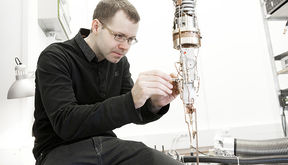Born to be a physicist

Professor Mika Sillanpää, what kind of research do you do, and why?
Low temperature nanophysics, which studies matter and phenomena at extremely low temperatures close to the absolute zero, is my field.
Coldness is important because the quantum phenomena in our research are so weak that we have to be able to get rid of the noise caused by temperature. Usually, quantum physics only applies to the individual elementary particles such as atoms, but if we can very thoroughly remove the vibrations caused by thermal motion, we can also observe the same phenomena in larger objects.
At the moment, my group and myself are trying to carry out experiments to prove quantum phenomena in moving objects, micromechanical resonators. They are like tiny drums of a size of one tenth of the diameter of a strand of hair. The idea is to have the resonator in a quantum-mechanical superposition, i.e. in a state in which the particles are in two places simultaneously.
My work is basic research, in which the strongest motivation is to do something that no one else has managed to do before. Also, quantum physics involves philosophical questions that have always fascinated me. Our research can be utilised in developing quantum computers. I believe that with help of superconducting quantum bits, qubits, we are likely to be able to build quantum computers within a few decades.
How did you become a researcher?
When I was little, I was already interested in nature and especially in physics. I liked watching the sky and the stars, and I devoured all the popular works on particle physics that I could find. My enthusiasm was so strong that my parents decided to take me to Switzerland to see CERN, the European Organization for Nuclear Research.
Many people end up as researchers, but I made a conscious decision. This career was an obvious choice to me. I studied in Otaniemi to get the degree of Master of Science in Technology and then started a doctoral dissertation at the university’s Low Temperature Laboratory.
What are the highlights of your career?
The breakthroughs in measuring the quantum mechanical properties of Josephson junctions that I made towards the end of my dissertation were significant. Another big success, which even made it to the cover of Nature, took place in Colorado, where I was a postdoctoral researcher for a couple of years after my dissertation. I was the first person to connect two superconducting qubits, like two huge atoms, through microwave resonance. In other words, I was able to bring them to a quantum superposition state. This discovery is related to the one that Serge Haroche and David J. Wineland were awarded the Nobel Prize in Physics in 2012. Recently, our group managed to find phenomena predicted by quantum physics in a micromechanical resonator. These phenomena, which were already examined at the end of the 1970s, are such small vibrations of micro-drums that the prevailing state could be described as a state quieter than silence.
What is the most important quality for a researcher?
Enthusiasm is the most important thing! My own work is high risk research, in which all ideas don’t always work. Without enthusiasm you can’t overcome difficulties.
What do you expect from the future?
I want to continue my research and be among the world’s top scholars in it.
More information about Mika Sillanpää in Aalto People
Mika Sillanpää and the other recently tenured professors at Aalto University will present their research in the multidisciplinary afternoon on 19 January. Welcome! Further information http://www.aalto.fi/en/current/events/installation_lectures_19012016/.
Read more news

Get to know us: Associate Professor Maria Sammalkorpi
Sammalkorpi received her doctorate from Helsinki University of Technology 2004. After her defence, she has worked as a researcher at the Universities of Princeton, Yale and Aalto.
Aalto computer scientists in ICML 2024
Computer scientists in ICML 2024
Getting bacteria into line
Physicists use magnetic fields to manipulate bacterial behaviour